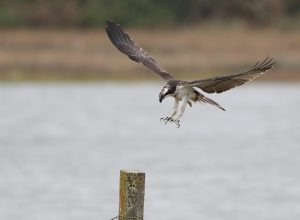Poole Harbour Ospreys
History of Ospreys in the UK and the Significance of Poole Harbour
Ospreys are the second-most widespread bird of prey in the world, after the Peregrine Falcon, residing on every continent apart from Antarctica. Previously widespread throughout Europe, Ospreys were historically persecuted until their numbers were extremely low, resulting in their extinction as a breeding bird in England in 1847. Like many other birds of prey, they were targeted to protect livestock, but their population was also impacted through egg and specimen collecting. Despite remaining in Scotland for a while longer, their population reached such low levels that they were no longer recognised as a breeding bird, with the last known pair breeding at Loch Loyne in 1916.
Fortunately, Ospreys made a natural comeback in Scotland, with the first known pair setting up a territory and nest at Loch Garten near Inverness in 1954. From there, the population slowly increased, with help from nest protection and public engagement initiatives, including “Operation Osprey” led by George Waterson, the then Director of RSPB Scotland, at Loch Garten. Despite these positive steps, populations remained low as egg-collection was still prevalent, especially as the Osprey eggs now had increased rarity. The population growth was further slowed through pesticide use, including DDT, which affected the quality of the eggs laid by the Ospreys. Only after harsher consequences for egg-collection and the ban on DDT in 1972, did the Osprey population in Scotland properly make a comeback, and by the 1990s there were over 60 pairs.

Photo by Simon Kidner
The nesting behaviours of Ospreys result in a very slow dispersal rate, as they frequently return to the area of the nest they fledged from. This meant that there were still no known nests in England, even 40 years after the pair settled at Loch Garten. With support from Roy Dennis, a world expert on Ospreys, a plan was formed to reintroduce Ospreys to England, through a landmark translocation project at Rutland Water in the East Midlands. In partnership with the Leicestershire & Rutland Wildlife Trust, as well as Anglican Water, the project started in 1996. 5 years after the project began, Ospreys returned as a breeding bird to England, with a nest both at Rutland and another in the Lake District, and later spread into Wales. After years of attempting to restore a breeding population to the South Coast naturally, the Poole Harbour Osprey Translocation Project was initiated to help spread their population further, with the hope of eventually linking the populations between Rutland, Wales and France.
Although there wasn’t a breeding population in Dorset at the time, Poole Harbour already hosted high numbers of Ospreys passing through from northern nests on migration in spring and autumn, and continue to do so. They can spend anywhere between a few hours and a few weeks in the harbour, stopping off to make the most of the abundant fishing opportunities. Historically, Ospreys were locally referred to as “Mullet Hawks” due to the high number of Grey Mullet, an ideal meal for the birds, in the harbour.
Call 01202 641 003
© 2024 Birds of Poole Harbour Registered Charity No. 1152615
